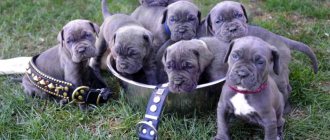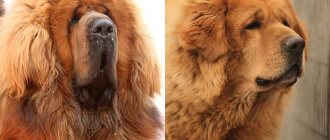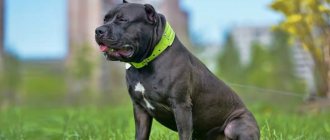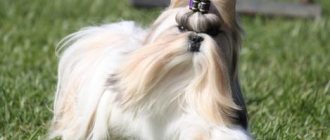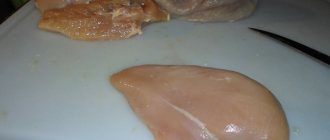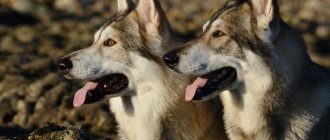Description of the Tibetan Mastiff breed
Popularity 131st among 263 dog breeds
Lifespan:
10-11 years
Height:
males: from 66 cm, females: from 61 cm
Country of origin:
China, Tibet
Average price:
50-70 thousand rubles
Weight:
64-78 kg
Latest articles Cat health
Rabies vaccination for cats: choice of vaccine, necessity, schedule 01/22/2022 4 0 0
Selection and adaptation
TOP 20 best cat breeds for families with children 01/22/2022 25 0 0
Key facts
The name of the breed is a kind of pointer to the country of origin of the dogs, Tibet, that is, China. The description of the Tibetan Mastiff breed allows for other names - Tsang-Khi, Molosser, Bho-Thai; abbreviated names (Tibetan, Mastiff) are used quite often. Nicknames should be chosen based on the “purpose” of the pet: watchdogs can be addressed briefly, while pets can be given long nicknames.
The life expectancy of the Tibetan Mastiff is relatively short - 10-12 years, but its health is excellent. Animals live active and full lives even in old age. In this regard, their character helps them: active, balanced, proud and in some ways even dominant.
The large size of the Tibetan mastiff makes it difficult to keep it in an apartment, but in a country house with a fenced area the animal will feel like in a palace. The average weight of a Tibetan mastiff is 64-78 kg (for females, a weight of 4 kg less than the norm is allowed, for males - 2 kg more). Height (height at the withers) for males starts from 66 cm, for females – from 61 cm.
The breed is not popular in the CIS, since for a long time it developed only in Tibet, China, and Nepal. You can count the number of nurseries breeding Tibetans on one hand. Rarity is one of the reasons why the price of purebred giants with a good pedigree starts at 60,000 rubles. But at the same time, the characteristics of the Tibetan Mastiff breed are almost impeccable.
Historical reference
Perhaps the Tibetan mastiff can be called one of the oldest breeds on earth. It is believed to be over 2500 years old. The first mention of these dogs dates back to 1121 BC. e. The Chinese book of Shu King mentions that mastiffs guarded monasteries, herds of yaks and the houses of monks. There is no exact information to help determine the origin of the breed. According to some sources, the ancestor of mastiffs was the black Tibetan wolf. And other studies show that the ancestor of the breed was the Chinese watchdogs of merchants who passed through the mountains of Tibet. Still others are completely sure that the Tibetan Mastiff is the ancestor of all modern Molosser breeds. The Molosser group is one of the largest on the planet. It includes bulldogs, boxers, St. Bernards, Rottweilers, etc.
Mastiffs appeared in Europe in the mid-19th century, when the Viceroy of India, Lord Hardinge, gave a Tibetan Mastiff puppy to Queen Victoria of England. Later, Edward VII brought two dogs with him to England. But the first offspring of mastiffs in Europe appeared only at the very end of the 19th century in the Berlin Zoo.
History of the origin of the Tibetan Mastiff
No researcher can say exactly where, when and how Tibetan mastiffs appeared. Dogs of this breed, judging by the many genetic analyzes carried out, are one of the direct descendants of wild wolves domesticated by ancient man. Archaeologists managed to find the remains of dogs similar to Tibetans that accompanied people living in caves. Mentions of man’s formidable four-legged friends are found in the works of Aristotle and Marco Polo.
One way or another, it is believed that the homeland of the Tibetan mastiff is Tibet. It was in this remote corner of the world that menacing-looking animals guarded the temples at night and were faithful friends and companions of the monks. The dog's ferocity, menacing gaze, powerful physique repelled all kinds of onlookers from the spiritual monastery. In addition, mastiffs protected the inhabitants of mountain villages from the invasion of strangers.
The breed was a kind of endemic for a long time, which allowed it to retain all its characteristic features. The Tsang-Khi first left Tibet, going to the Chinese Emperor as a “trophy”. It’s easy to guess that dogs soon became an indispensable element of wealth. In addition, Tibetans were presented to representatives of many Asian countries, which gave impetus to the development of other similar breeds.
The nineteenth century was marked by the arrival of Tibetan mastiffs to Europe, more precisely to Great Britain: first, the King of India gave Queen Elizabeth a Tsang Khi puppy, then Edward VII brought several puppies to the United Kingdom. Aristocrats became interested in these unusual animals after an exhibition at the Alexander Palace (cultural and entertainment center), and Tibetan mastiffs became full-fledged residents of Foggy Albion, from where they spread throughout Europe. The time it took to win the hearts of Europeans was about fifty years.
1931 was marked by the creation of a breed standard (Frederick Bailey's wife had a hand in this) and its inclusion in the register by the Association of Tibetan Dog Breeds. The Kennel Club took it as the basis for forming its own list of traits inherent in Tibetan Mastiffs.
The period of the Second World War was equally difficult for all representatives of rare breeds, including Tibetans. Breeders of the period 1939-1945 made every possible effort to preserve the gene pool of Tibetan mastiffs, because due to the occupation of some countries, the supply of new individuals to the mainland stopped. Having restored the Tsang-Khi population, the breeders decided to give a gift to the American President - a faithful friend who did not make the right impression on the politician and was sent to the ranch.
Twenty years later, the position of the breed in the United States improved due to the importation of new purebred individuals from Tibet. In 1969, the Americans achieved the opening of the Association of the American Line of Tibetan Mastiffs. Ten years later, American individuals took part in the exhibition and received their share of attention from breeders from other countries.
Today the breed remains at the peak of popularity in China (where they are willing to pay a lot of money for its representatives), but in other countries only a few are involved in keeping four-legged giants. Purebred individuals are a rare occurrence in large countries such as Great Britain and America, but in smaller countries things are not the best. In our country there is no talk of opening a nursery due to the small number of animals of this breed located on its territory.
Appearance of the Tibetan Mastiff
General impression
What does Tsang Khi look like? What can be seen from the photo: Tibetan mastiffs are large, massive, but proportionally built. The muscles are dense, a large accumulation of fat under the skin, even despite being well adapted to the cold, is small and evenly distributed. Animals may differ in appearance or physical structure depending on their habitat and the nutrition they receive as puppies.
Head
The head looks broad and heavy. The skull is rounded, the occipital protuberance and stop are well defined. Triangular ears are located just below the skull, falling forward; When a Tibetan experiences strong emotions, the ears move actively.
The square-shaped muzzle is wide and well filled. Eyes with tight-fitting eyelids are oval or semi-oval in shape, slightly squinting. Brown color and its various variations are desirable (either the color of the iris close to the color of the coat, or dark brown). The nostrils of the black nose are well open. With its fleshy lips, the dog covers the lower jaw with a regular scissor bite (a direct bite is allowed).
Neck
A strong and muscular neck is prescribed for Tibetans, as is a well-defined scruff. Males have thicker fur than females.
Torso
The body is powerful, with a straight back and wide croup. The lower part of the deep, moderately broad chest falls below the elbow joints; ribs are rounded. The muscles of the body are well developed.
Forelegs
Strong bones of straight paws, an average slope of the shoulders, elbow joints facing backwards, and straight forearms are prescribed for Tibetan Mastiffs according to the standard. The pasterns are slightly inclined. The muscles of the paws are developed. The paws are round, the toes are curved. The fur collects in clumps between the fingers. The color of the dense pads is black.
Hind limbs
The parallelism of the hind legs is noted. The croup is voluminous, the hips are strong. The stifle joint is well defined, the hock joint is low and strong. Developed muscles allow you to make good pushes. The paws are rounded, the toes are curved. The color of the pads is black.
Tail
The high-set tail is long enough to fall down the back. If the animal is excited or hostile, the tail is thrown freely over the croup or kept a couple of centimeters from it.
Movements
The movements of the Tibetan mastiff show sedateness and importance. When walking, the fluffy giant pushes easily and evenly with both hind and front paws. During running, the emphasis shifts to the hind limbs due to more developed muscles.
Wool
The Tibetan Mastiff's coat is distinguished by the coarseness of its short guard hairs. In winter, the undercoat is thick; by summer, during spring molting, the amount of hair is reduced by one-half. Abundant fur is observed on the neck, shoulders, and tail.
Color
What colors are typical for the hairy giant? There are five types of Tibetan mastiff colors: black, black and tan, blue (gray), golden (all possible shades from wheaten to reddish), sable. Purity of shade is welcome, but there may be some scorching on the shins and lower part of the tail. The eyes may be surrounded by glasses. The color of the tan marks depends on the color of the furry giant.
Size
Tsang-khi are large breed dogs that grow up to four years. Weight increases in proportion to height; animals are genetically protected from obesity. Compared to an adult giant, a one-month-old puppy is very small, but every month it gains weight (norms for weight gain can be found from the breeder or can be found on the Internet). “Boys” and “girls” have quite large differences in physical parameters. With a minimum height of 66 cm, a male weighs from 72 to 80 kg; The height of Tibetan mastiff females is slightly smaller, 61 cm, and their weight is from 60 to 75 kg.
Character of the Tibetan Mastiff
Do not be afraid of its menacing appearance: the Tibetan mastiff is affectionate and quite good-natured. Balance and independence are in the dog’s blood, just like other breeds in this region. The Tibetan does not need constant attention from the owner due to its highly developed independence, which makes it different from dogs of small breeds: the animal can easily communicate the need for a walk, choose a time for playing outside, sleeping, and eating. Aggression and inadequacy are rare among Tibetan mastiffs, as they are considered the reason for not allowing an individual to breed. But despite this, dogs become excellent guards. Their loud bark is surprisingly booming.
Keeping such a giant (even a puppy) in an apartment is impossible due to its size, but it is important for a Tibetan to feel involved in the life of the “pack,” so the dog’s life should take place at home. At home the dog will behave approximately. Tsang-khis are affectionate with children (it is not recommended to leave children alone with animals due to their size), and they easily get along with other animals - even cats and dogs of the same sex. This allows us to conclude that the character of the Tibetan mastiff is as calm, friendly and balanced as possible.
Walking with Tibetans is a real pleasure. They look great outside in winter.
Tsang-khis are surprisingly smart and obedient. Thanks to this, furry giants can be trained with due care and patience of the owner. The owner becomes the “pack leader” for the Tibetan Mastiff, and carrying out his commands is a priority. When in the company of a stranger, a Tibetan will attack only on the orders of the owner.
Who is Tsang Khi suitable for? An authoritative person who has already kept a dog. If you have a dog of this breed, get ready to switch to an active lifestyle. Only the Tibetan owners know how cheerful animals can be when they explore this world.
Pros and cons of the breed
Purebred Tibetan Mastiffs are more expensive than other breeds on the planet. Before spending money, you need to think about all the positive and negative qualities of the animal and compare them with your own capabilities.
Positive qualities include the following:
- Remarkable guarding skills of the Tibetan Mastiff.
- Character – dogs are friendly and kind to their charges.
- They are undemanding to a high level of living conditions and nutrition - but this does not mean that it is completely unnecessary to pay attention to them. Otherwise the dog will get sick.
- Independence.
- Cold resistance.
Negative qualities:
- Unsuitability for living in an apartment due to its size.
- Stubbornness.
- A strong voice and a love for using it.
- Shedding.
Even though there are more pros than cons, the latter may be more significant in some living conditions.
Education and training
Raising and training a Tibetan mastiff can be either easy or difficult - it all depends on the relationship between the owner and the pet. Dogs of this breed are smart but stubborn. An animal may not obey the owner if it does not recognize his authority (this is why it is not recommended for inexperienced dog breeders to own a dog of this breed). Such behavior of a Tibetan can be eradicated: one should be more patient, tactful and perspicacious.
It is recommended to start teaching a puppy simple commands at the age of one month, and full training only three or four months after birth. On average, Tsang Khi acquires the necessary skills in two years.
Training is best done under the supervision of a dog handler, outdoors (it doesn’t matter whether it’s winter or summer, spring or autumn outside). At first, each training session will be devoted to performing only one exercise, then, after the Tibetan has mastered several commands, two or three. A trained and well-mannered furry giant will always follow the instructions of the owner, even if instinct prescribes a completely different behavior in the situation.
In the matter of obedience to the owner, the aspect of trust is also important. If during training the animal does not ask for affection for a well-performed trick, does not try to lick the owner, but only eats treats, looking sideways at the person, it is worth thinking about where the mistake was made in the upbringing. Such an attitude towards the owner leads to problems with socialization.
How to raise a Tibetan? Questions are often asked: how to train a Tibetan mastiff not to bark at strangers, how to wean a puppy from gnawing wooden objects, and whether it is possible to swear at him. If it is not possible to contact a breeder or dog handler, then you should be patient and show the animal (in a gentle way) that such behavior is unacceptable (you cannot use screaming). We also must not forget about the importance of early socialization: mastiffs are very self-centered.
Who is this breed suitable for?
The power and beauty of this breed is both daunting and captivating at the same time. Many people would like to get such a giant as a pet. But before you get a Tibetan Mastiff puppy, you need to think carefully about this step.
This dog is suitable for owners of large houses with an impressive territory. Since the Tibetan Mastiff cannot be kept on a chain, it will need freedom to move. If you have a poorly fenced area, you will have to build a high and durable fence. It will be easy for a dog of this size to jump over a low fence or dig a hole under it. For apartment owners, even large ones, the Tibetan Mastiff will not be the best option.
You need to spend time actively with your dog. Even if you live in a private house, the dog needs to be walked outside. If you don't pay attention to your dog, it will start to get bored. In order to somehow entertain himself, the dog will begin to play dirty tricks and attract attention to himself.
Photo of Tibetan Mastiff
Raising and training this breed requires a lot of time and effort. It will take endurance and patience. Therefore, this breed is not suitable for people who are hot-tempered and aggressive, as well as too soft and compassionate. It is important for the Tibetan Mastiff to feel like a leader in its owner.
The dog will have no problems with children. She will become their big plush friend. But if there are very young children in the family, then you need to make sure that the dog does not inadvertently injure them. He may accidentally crush the baby with his body weight or knock him down.
You need to spend time caring for your dog. If you don't take care of her fur, it will get matted. They not only spoil the dog’s appearance, but also cause him inconvenience. Talk to your neighbors in advance and warn them that you are getting a Tibetan Mastiff. After all, his loud barking can disturb them. If you wake up at dawn and go to bed early, you should be prepared for the nocturnal activity of these dogs. It is in the evening that they prefer to communicate with their owners.
Fans of noisy parties will be disappointed that the dog will not share their hobbies with them. Representatives of this breed prefer silence and solitude.
Anyone who gets a Tibetan mastiff must be prepared to spend money on its food. To feed such a bear cub, you will need a high-quality diet in considerable quantities. If you already have animals, difficulties may arise. It is better to take a Tibetan Mastiff as your first pet. Or “add neighbors” to him while still a puppy.
Tibetan Mastiff Health and Diseases
Possible diseases
The Tsang-Khi are surprisingly healthy (this is due to living for many years in the snow-capped mountains), but their life expectancy is short. The furry giants even have a gene responsible for preventing the development of obesity. But, despite this, large body weight is normal for the breed, as a result of which diseases of the musculoskeletal system develop.
Diseases of the endocrine system and eye diseases may occur. In addition, Tibetans are susceptible to ear infections, because their ears are in constant contact with fur, which is why they are not ventilated enough.
The most common diseases are:
- Hip dysplasia is an inherited pathology that results in impaired development of the head of the hip joint. It appears while walking - the pet cannot step on its paw normally;
- elbow dysplasia;
- eye diseases (entropion or eversion of the eyelids);
- baldness (most often the tail is affected);
- rickets;
- thyroid diseases;
- dermatitis (due to the abundance of hair, an animal living in damp rooms can acquire this disease);
- autoimmune hypothyroidism is a chronic disease characterized by the production of lymphocytes that produce antibodies to thyroid cells.
It is necessary to monitor the condition of the Tibetan Mastiff's muzzle: rubbing the eyes and nose should become a constant part of the pet's daily toilet, as well as combing. Oral diseases are not typical for Tibetans, but it is important to monitor the condition of your pet’s teeth - caries or tartar may occur. Allergies in dogs of this breed are rare.
Reproductive health
A special topic is the health of bitches. Their life is inextricably linked with the birth of offspring. The first heat occurs at approximately two and a half years of age. It is better to postpone pregnancy planning and childbirth to the second or third heat.
If the owner is not financially ready to breed Tibetans (it is important to think about who the breeding will take place with, what to feed the puppies after weaning from the female, how documents will be drawn up, and marks for receiving vaccinations), the best option would be sterilization. In this case, you will not have to spend money on expensive treatment and recovery after childbirth.
Video about the breed
In conclusion, it is worth noting points that require attention and patience.
The Tibetan Mastiff is a difficult breed to train and requires a strong and strong-willed owner who can give the dog the required amount of attention every day. When choosing such a dog, you need to be prepared to monitor your pet’s every step for the next ten years, monitor its health, well-being and mood, and visit the veterinarian on time. Otherwise, living side by side with such a dog will bring inconvenience.
A caring owner will receive a faithful friend who will please him throughout his life.
Features of feeding and diet
Proper nutrition should accompany the Tibetan Mastiff from birth. The formation of an individual ends at four years of age; until this moment it is better to use the puppy’s feeding guide, otherwise there is a high chance of not taking into account all the subtleties of building the animal’s diet. The consequence may be weakness of the muscle corset, brittle bones (a month-old puppy must receive the required amount of calcium). Every month the amount of food consumed by the mastiff will increase - feeding is considered the most expensive part of keeping Tibetan mastiffs.
Whether to base the diet on natural food or gradually switch the animal to dry food is up to the owner of the Tibetan mastiff to decide. Mixing two types of diet is strictly prohibited, as this can lead to indigestion and other problems with the gastrointestinal tract.
If the owner decides to leave the pet on a natural diet, then he should purchase a guide on feeding an adult dog. Such manuals prescribe the norm for obtaining KBJU and microelements, an approximate diet, and also state whether the animal can consume certain foods.
Products recommended for inclusion in the diet include:
- beef;
- offal (except chicken bones);
- lean meats and poultry (rabbit, chicken, turkey);
- sea fish and seafood;
- cereal porridge;
- unsweetened vegetables and fruits;
- fresh vegetables (except starchy vegetables);
- vegetable fats (oils).
When transferring a furry giant to food, you should pay attention to the animal’s body’s reaction to the components of the food. The transition occurs slowly: at first, food is added to the food in small handfuls, then most of the food is replaced by dry food and, in the end, the animal is completely transferred to food. It is possible for the food to soften in water, especially if the puppy is being fed.
Typically, an adult Tibetan receives two servings of food per day, a puppy – three to six servings. The amount of food depends on age. Water should be available all day and should be changed every two hours.
Care and maintenance
The Tibetan Mastiff dog is very large, which makes keeping it in an apartment problematic. A country house would be a good option for a Tibetan, but the dog cannot be kept completely outside, as it needs constant communication with its owner. Also, you cannot put a Tibetan mastiff on a chain, this will harm the animal’s psyche. For a four-legged guard, you can build a spacious enclosure. Do not forget that such a dog must be walked outside the territory of its residence.
How to care for a Tibetan Mastiff dog? The Tibetan's coat, due to its origin and long residence in mountainous areas, is very thick. The dogs are long-haired. It will take some time to care for her. It is especially difficult to care for a mastiff in the spring, when the molting period begins: every evening you will have to devote to combing your pet and removing tangles.
The rest of the time, it is enough to comb the Tibetan 2-3 times a week.
Often the appearance of tangles, which are removed using a tangle cutter or a special spray. Bathing a mastiff occurs infrequently: once every three months. If you don't have enough time, you can use dry shampoo.
Claws are trimmed as they grow, mainly in winter, since during this period the pet is not able to grind them off on the asphalt on its own. This procedure is carried out using a nail clipper for large dogs, and the remaining irregularities are ground down using a hard file. The fur often gets tangled between the Tibetan's fingers, which is why it is cut once a month.
Mastiff ears need just as much care. As the auricle becomes dirty, wipe it with a cotton swab soaked in chamomile infusion. Eyes that become dirty due to hair getting into them are wiped with boiled water every two days.
The oral health of a pet is entirely in the hands of the owner. It is recommended to brush your pet's teeth twice a month. An unpleasant but important procedure for khi is carried out using a toothbrush or a finger attachment, as well as a special toothpaste. You can free the Tibetan Mastiff from unpleasant manipulations by introducing into the diet special treats developed by specialists to prevent the appearance of plaque.
Tibetan Mastiffs participating in exhibitions should visit the groomer once every one and a half to two months. Pet-class or breed-class dogs are recommended to visit a specialist at least once every six months. Grooming includes a range of services: haircut, teeth and ear cleaning, nail trimming, and fur combing. Otherwise, the care and maintenance of the Tibetan mastiff falls entirely on the shoulders of the owner.
Tips for choosing a puppy
How to choose a Tibetan Mastiff puppy? The choice is quite difficult, given the small number of nurseries engaged in breeding. Tibetans must be kept in good conditions: sleep and play in spacious rooms, and receive premium food after weaning. Tibetan Mastiff puppies with good pedigree can be purchased from the following kennels:
- Liontari Asteri (Saratov);
- Zatveretsky Posad (Tver);
- Sei Taishougum (St. Petersburg);
- AlpiNEN Gold (Belgorod);
- Light Stacy (Bryansk);
- Like Vizhe Trel (Moscow);
- Pharaoh's Dream (Moscow region).
It is advised to consult a breeder or dog handler, the cost of which is usually not high. A healthy puppy is curious and playful. A neat, healthy appearance, absence of suppuration on the skin or mucous membranes, fluffy but not crumpled hair is a good sign. Before buying, it is better to talk with the parents of your future four-legged friend to find out whether the puppy will be aggressive, cowardly or overly angry.
The price of a little Tibetan depends on the quality of his care after birth and the availability of documents (puppy birth certificate, which can be exchanged for a pedigree upon reaching a year, a veterinary passport with notes on vaccinations performed).
How to choose a puppy
It is best to buy a Tibetan Mastiff from nurseries that breed this breed. If pedigree is important to you, ask the breeder to provide all the information and photographs of adults who will later produce offspring. At the same time, you can book a puppy from a specific mastiff pair or take the baby you like four weeks after its birth.
Puppies should be kept in a spacious and carefully cleaned environment and should be playful and have a healthy curiosity. Carefully examine the baby's skin and mucous membranes. The eyes and nose should be clean and free of painful-looking discharge. Ideally, pustules and other types of irritation are also absent. A small Tibetan should be moderately heavy and well-fed, with a wide muzzle and thick feet. The thicker the coat, the better. Please note that the puppy should not be cowardly or aggressive.
Listen to your heart - and it will not deceive you!
